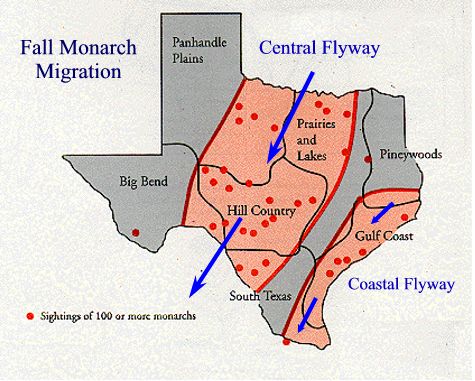With a push from the north wind, monarchs streamed into Texas this week.
"There was a major uptick in the number of monarchs today! A cold front passed through Saturday night and, as expected, the numbers jumped afterwards when the sun came out." October 7, Matt Irwin, Dallas, Texas
"There were a lot of Monarchs parked near Oklahoma City for a week, and prevailing wind was south or east (not north anyway) for several days," observed Gregg Lee who reported the largest roost for Texas on October 6th.
Late Northern Sightings
A surprising number of northern observers saw a strong flow of monarchs this week. Some even saw their highest counts of the season.
"A steady stream of monarchs are flying south west along the Lake Erie shoreline. About 300 butterflies per hour are moving through at tree top level or higher, with the odd one dropping down to fill up on nectar. It is not unusual to see a good migration tail this time of year. What was unusual this year was the lack of butterflies during the normal peak migration which occurs around September 15 at Clearville Park."
October 4, Steve Rankin, Clearville Park, Ontario
"Peak migration. Our butterfly bush was practically swarming with Monarchs all afternoon. The bush is in full sun and the temperature was about 17ºC."
Jennifer McPherson, October 8, Oakville, Ontario
Effects of a Warm Fall
Warm temperatures are giving monarchs more time to develop into adult butterflies. Also, persistent warm air masses with their southerly winds could be delaying migration.
Migration Window Closing
Late flyers are less likely to reach Mexico says Dr. Chip Taylor of Monarch Watch in Kansas.
"A fair number of monarchs are still in the area— two days before the end of the 'migration window' (4 October). We see monarchs after this date but the numbers diminish rapidly and tagging shows that the probability of monarchs reaching Mexico is less than 1/15th that of monarchs tagged within the migration window."
October 2 Lawrence, Kansas
|













